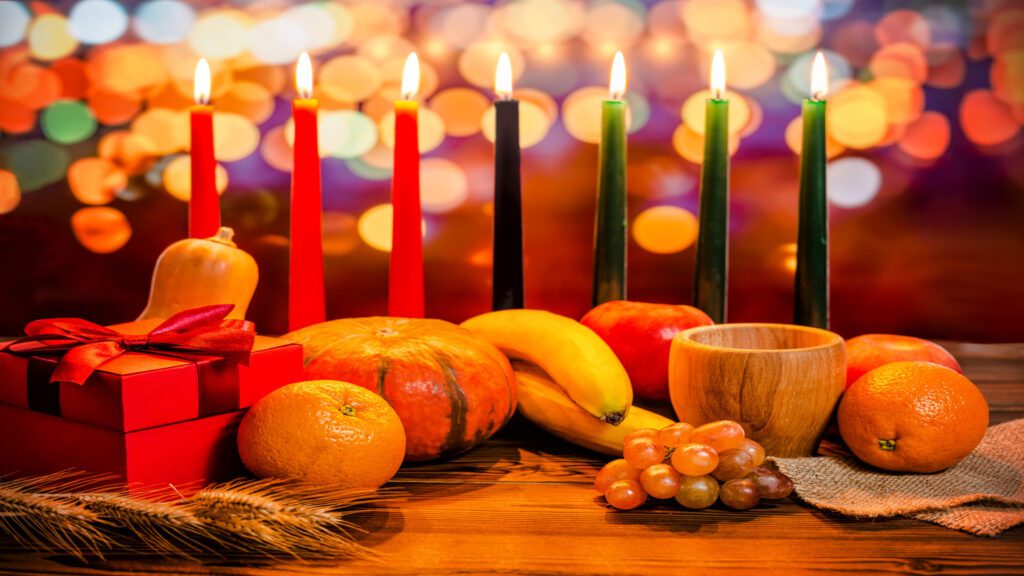Born out of racial inequality in the United States, Kwanzaa is a celebration of African heritage, observed annually since 1966. It’s a time for celebration and reflection, when families come together to share gifts and feasts and pay tribute to their ancestors and their future. From its origins to its traditions, here is what you should know about Kwanzaa history and celebrations.
What is Kwanzaa?
Kwanzaa is a week-long observed every year from 26 December to 1 January, to celebrate African culture, heritage and unity. The name Kwanzaa comes from the word “first” in Swahili, inspired by the start of the harvest season and the harvest traditions in West and Southeast Africa.
GET INSPIRED BY: Journey Along the Civil Rights Trail
The origins of Kwanzaa
First celebrated in 1966, activist Maulana Karenga founded Kwanzaa. He created Kwanzaa a year after the Watts neighbourhood rebellion in Los Angeles, California. After years of police brutality and poverty, the frustrated community rioted, leaving 34 people dead and 1,000 injured. In response to the rebellion, Karenga founded the Us Organisation to rebuild the community and inspire a Black cultural revolution.
Through Kwanzaa, Karenga wanted to establish a secular holiday for African Americans to honour their African heritage and cultural connections. It was also intended as an alternative to the dominant Christmas celebrations, which promote consumerism and images of a white Jesus Christ. Karenga wanted Kwanzaa to draw on the traditions and symbols of African countries. He saw the African harvest festivals as an ideal model of values for communities and cultures.
RELATED CONTENT: 12 inspiring black history sites to visit


How to celebrate Kwanzaa?
Kwanzaa festivities start on 26 December and run for seven days. Each day is marked by symbols and rituals.
Seven days, seven principles
Each of the seven days of festivities represents one of the seven Nguzo Saba (principles) of Kwanzaa. The principles include unity (umoja), self-determination (kujichagulia), collective work and responsibility (ujima), cooperative economics (ujamaa), purpose (nia), creativity (kuumba), and faith (imani).
RELATED CONTENT: 8 places to visit to honour Martin Luther King Jr
//www.instagram.com/embed.js
Seven symbols
Seven symbols represent the seven Nguzo Saba. The symbols are fruits, vegetables, and nuts; a straw mat; a candleholder; ears of corn (maize); gifts; a communal cup signifying unity; and seven candles in the African colours of red, green, and black.
The first day is when people lay a straw mat over a table. They decorate it with symbolic items like fruits and vegetables, corn ears to symbolise children, and a kinara (candleholder). The kinara has special significance as each night, families gather to light the kinara and share their wisdom about the daily Nguzo Saba.
//www.instagram.com/embed.js
A black candle sits in the centre of the kinara, with three green candles on the right and three red candles on the left. Families light the black candle on the first day to represent people of African heritage. The green and red candles are lit alternatively for the remaining six days. The red candles symbolise the blood of their ancestors, while the green candles represent life, earth, and the future. This is to show “the people come first, then the struggle, then the hope that comes from the struggle”.
As part of the evening candle ceremony, an elder fills a unity cup with juice or wine. They pour some of it into the earth to honour their ancestors. The elder also drinks from the unity cup and then passes it around the group, chanting harambee (meaning “let’s pull together” in Swahili) seven times.
Karamu
On the sixth day – 31 December – communities gather for a feast known as karamu. The feast is a time for renewal, joy, and bonding. You’ll find lots of music, dancing and small gifts for children.
RELATED CONTENT: 8 Black pioneers who changed travel for the better
The evolution of Kwanzaa
In its early years, Kwanzaa struggled to attain recognition. However, it became more mainstream in the 1980s and 1990s as it spread by word-of-mouth and featured in the media. In 1993, Bill Clinton became the first US president to recognise Kwanzaa. He said: “At a time when we are seeking ways to revitalize our neighbourhoods and empower those who have been powerless for too long, Kwanzaa encourages us to rebuild and gives us the opportunity to celebrate the strengths of the African American community”. In 1997, the US Postal Service issued the first Kwanzaa stamp.
In recent years, estimates show that anywhere from one to 12 million Americans celebrate Kwanzaa. It’s also spreading widely beyond the US, particularly the Caribbean and other regions with large populations of African descendants. As the US continues to struggle through racial inequality and unrest, with the murders of George Floyd, Breonna Taylor, and many more, it seems more Americans are recognising Kwanzaa as a way to celebrate African American culture and Black family life.
RELATED CONTENT: 6 African American sights on our Civil Rights Trail tour
If you want to find out more about Kwanzaa and how to celebrate it, head to the official Kwanzaa website.
Do you celebrate Kwanzaa? Let us know in the comments below!